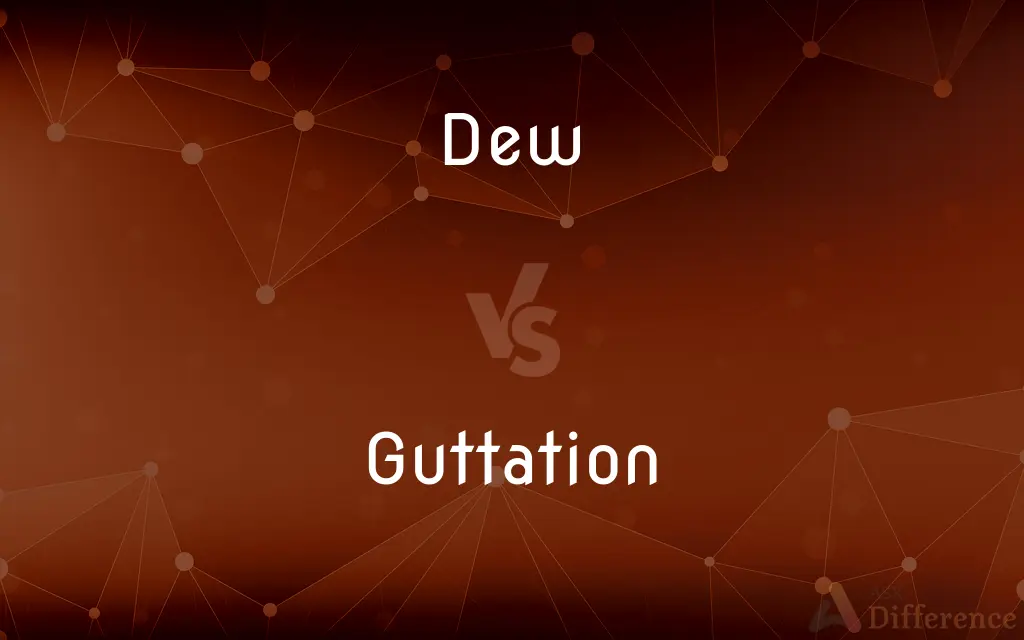Dew vs. Guttation — What's the Difference?
Edited by Tayyaba Rehman — By Fiza Rafique — Updated on March 11, 2024
Dew forms from atmospheric moisture condensing at night, while guttation involves plants exuding water from leaf tips, distinct in origin and appearance.

Difference Between Dew and Guttation
Table of Contents
ADVERTISEMENT
Key Differences
Dew results from the condensation of atmospheric moisture on surfaces during cooler nights when the surface cools below the dew point of the surrounding air. This process leads to the formation of water droplets on surfaces like grass, leaves, and cars. On the other hand, guttation occurs when root pressure forces water to exude from the tips or edges of a plant's leaves, forming droplets.
While dew forms externally from the air's moisture, guttation is an internal process driven by the plant's physiology. Dew can form on any cool surface under the right conditions, but guttation is specific to certain plants under conditions of high soil moisture and cool temperatures.
The water droplets from dew are purely made up of water condensed from the air and can occur on any surface that's cooler than the air's dew point. In contrast, guttation droplets contain a mix of water and various dissolved substances from the plant, which can leave residue once the water evaporates.
Dew formation is largely influenced by weather conditions, such as humidity and temperature, and can be observed widely in nature and on man-made objects. Guttation, however, depends on the plant's water status and root pressure, and is usually seen in the early morning before evapotranspiration begins.
Although both phenomena result in water droplets appearing in the morning, the droplets' size can vary. Dew droplets tend to be smaller and more uniformly distributed over surfaces, while guttation droplets are often larger and found specifically at leaf edges or tips.
ADVERTISEMENT
Comparison Chart
Origin
Atmospheric moisture condensation
Exudation due to root pressure
Occurrence
On any cool surface
Specific to certain plants
Composition
Pure water
Water and dissolved substances
Influencing Factors
Humidity, temperature
Soil moisture, plant physiology
Residue
No residue
May leave residue
Compare with Definitions
Dew
Water droplets formed by condensation of atmospheric moisture on cool surfaces.
The morning dew covered the grass with tiny droplets.
Guttation
Caused by root pressure in conditions of high soil moisture.
After watering the garden at night, guttation was evident in the morning.
Dew
Occurs when a surface cools below the air's dew point.
The car's roof was coated in dew after a cool night.
Guttation
Contains a mix of water and dissolved substances.
Guttation droplets left a white residue on the leaves.
Dew
Can form on any surface, natural or artificial.
Dew glistened on the spider's web in the early morning.
Guttation
The exudation of water droplets from the tips or edges of leaves in certain plants.
Guttation droplets were visible at the leaf tips of the strawberry plant.
Dew
Leaves no residue after evaporation.
The dew evaporated quickly as the sun rose, leaving no trace.
Guttation
Specific to certain plants under particular conditions.
Tomato plants often show guttation at dawn.
Dew
Influenced by weather conditions like humidity and temperature.
Dew is more likely to form on clear, calm nights.
Guttation
Dependent on the plant's water status and physiology.
Guttation is common in plants with a well-developed root system in moist soil.
Dew
Water droplets condensed from the air, usually at night, onto cool surfaces.
Guttation
Guttation is the exudation of drops of xylem sap on the tips or edges of leaves of some vascular plants, such as grasses, and a number of fungi. Guttation is not to be confused with dew, which condenses from the atmosphere onto the plant surface.
Dew
Dew is water in the form of droplets that appears on thin, exposed objects in the morning or evening due to condensation. As the exposed surface cools by radiating its heat, atmospheric moisture condenses at a rate greater than that at which it can evaporate, resulting in the formation of water droplets.When temperatures are low enough, dew takes the form of ice; this form is called frost.
Guttation
The exudation of water from leaves as a result of root pressure.
Dew
Moisture from the atmosphere condensed by cool bodies upon their surfaces, particularly at night.
Her tears fell with the dews at even.
Guttation
(botany) The exudation of drops of water from the leaves of some vascular plants as a result of root pressure.
Dew
Something moist, fresh, pure, or renewing
"The timely dew of sleep / ... inclines / Our eye-lids" (John Milton).
Dew
Moisture, as in the form of tears or perspiration, that appears in small drops.
Dew
To wet with or as if with dew.
Dew
(uncountable) Any moisture from the atmosphere condensed by cool bodies upon their surfaces.
Dew
(uncountable) Moisture in the air that settles on plants, etc in the morning or evening, resulting in drops.
Dew
An instance of such moisture settling on plants, etc.
There was a heavy dew this morning.
Dew
(figurative) Anything that falls lightly and in a refreshing manner.
Dew
(figurative) An emblem of morning, or fresh vigour.
Dew
To wet with, or as if with, dew; to moisten.
Dew
Figuratively, anything which falls lightly and in a refreshing manner.
Dew
An emblem of morning, or fresh vigor.
Dew
To wet with dew or as with dew; to bedew; to moisten; as with dew.
The grasses grewA little ranker since they dewed them so.
Dew
Same as Due, or Duty.
Dew
Water that has condensed on a cool surface overnight from water vapor in the air;
In the morning the grass was wet with dew
Common Curiosities
What causes dew to form?
Dew forms from the condensation of atmospheric moisture on surfaces that cool below the dew point.
Why do guttation droplets sometimes leave a residue?
The residue is from dissolved minerals and substances in the plant's xylem water, which are left behind after the water evaporates.
Does guttation indicate overwatering?
While not always, frequent guttation can indicate excessive soil moisture, which might suggest overwatering.
Is guttation harmful to plants?
Guttation is not typically harmful and is a normal physiological process for some plants.
How does guttation occur?
Guttation occurs due to root pressure pushing water out through special leaf tips or edges in certain plants.
Can dew form on any surface?
Yes, dew can form on any surface, natural or artificial, that cools below the air's dew point.
How can you differentiate between dew and guttation?
Dew forms on any cool surface due to condensation, while guttation is plant-specific and results from internal water pressure.
Can both dew and guttation occur on the same plant?
Yes, a plant can exhibit both dew on its surface from atmospheric condensation and guttation at its leaf edges or tips.
Why is dew common in the morning?
Overnight, surfaces cool down, making morning the most likely time for atmospheric moisture to condense into dew.
What factors influence the formation of dew?
Temperature, humidity, and surface cooling rate are key factors influencing dew formation.
Under what conditions is guttation most likely to occur?
Guttation typically happens under high soil moisture conditions and when transpiration is low, usually at night or early morning.
Is guttation a sign of a healthy plant?
Guttation is a normal physiological process and can indicate that the plant has a robust root system and is actively taking up water.
Do all plants exhibit guttation?
Not all plants exhibit guttation; it is more common in certain species with specific anatomical features that facilitate this process.
Can guttation occur on indoor plants?
Yes, guttation can occur on indoor plants, especially if the soil is moist and the plant is in a cool, humid environment.
What role does weather play in dew formation?
Clear, calm nights with high humidity are ideal for dew formation as surfaces cool below the dew point without wind dispersing the moisture.
Share Your Discovery

Previous Comparison
Glimmering vs. Glistening
Next Comparison
Meloxicam vs. TizanidineAuthor Spotlight
Written by
Fiza RafiqueFiza Rafique is a skilled content writer at AskDifference.com, where she meticulously refines and enhances written pieces. Drawing from her vast editorial expertise, Fiza ensures clarity, accuracy, and precision in every article. Passionate about language, she continually seeks to elevate the quality of content for readers worldwide.
Edited by
Tayyaba RehmanTayyaba Rehman is a distinguished writer, currently serving as a primary contributor to askdifference.com. As a researcher in semantics and etymology, Tayyaba's passion for the complexity of languages and their distinctions has found a perfect home on the platform. Tayyaba delves into the intricacies of language, distinguishing between commonly confused words and phrases, thereby providing clarity for readers worldwide.
















































